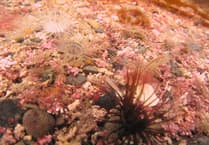Several years ago, I was helping a colleague with an intertidal survey on the island’s south-west coast. The spring tide enabled us to reach the normally inaccessible lowest parts of the shore.
Anyone who has peered into rock pools will have seen the flat pink-encrusting red algae covering low-shore rocks, cobbles and shells. It’s everywhere, but not particularly recognisable as anything in particular despite its eye-catching colours.
On this particular early morning trip, we came across a large, shallow and mirror-flat rockpool completely lined in glorious pale-pink coralline algae, but composed of convoluted ridges and flutings, and looking more like a field of pink and purple flowers.
The common name of these types of red algae is paint weed, or coralline crust and, where conditions are good, they can grow undisturbed with adjacent individuals of the same species crinkling up at the edges where they meet, growing upwards into these complex three-dimensional structures. By contrast, different species often grow over each other, forming colourful patchworks of pink and purple.
Apart from requiring relative peace and quiet to develop like this, they also require time and lots of it. With growth rates of less than 7mm per year, the more complex formations may take decades, perhaps a 100 years to reach this complex state of development.

In Manx waters there are actually several species and their vivid descriptive names (both scientific and common) provide a sense of the colours and form we see in nature. Some of the local species include phymatolithon lenormandii (shore paint weed); phymatolithon purpureum (purple paint weed); lithophyllum incrustans (pale paint weed); lithothamnion sonderi (deep pink paint weed) and lithothamnion crouaniorum (overgrowing paint weed).
What is particularly noticeable at this site is the diversity of other animals living in the pool. In the previous article we noted that these types of red algae (as maerl) seem to provide attractive conditions for scallop juveniles. But the diversity in this pool was even more impressive.
The common limpets (patella vulgata – yes, patella like the knee bone) in the pool looked like a crazy wedding cake decorator had been let loose with an icing bag!

The general abundance of pink paint weeds in the pool also vividly showed the home scars of the limpets, as rocky circles in an otherwise pink landscape. The home scar is the position that limpets return to, forming a perfect water-tight seal against the rock, and the presence of, and possible grazing by the limpets prevents colonisation by the algae.
Perhaps even more noticeable, was the presence of vivid, red beadlet anemones (actinia equina) sitting perfectly within the limpet home scar, obviously an easier place to set up home compared to on top of the encrusting red algae, which have various defence mechanism to stop other organisms from colonising them.
Within this single pool these examples demonstrate a number of important ecological concepts, such as competition, colonisation and succession, which is why rocky shores around the island have always been important study sites for scientists and students.
Of course, we can all appreciate the beauty of these places for their own sake and, since they take decades to form, it emphasises the important conservation and education work undertaken by DEFA, the Manx Wildlife Trust and others in protecting these sites for future generations.





